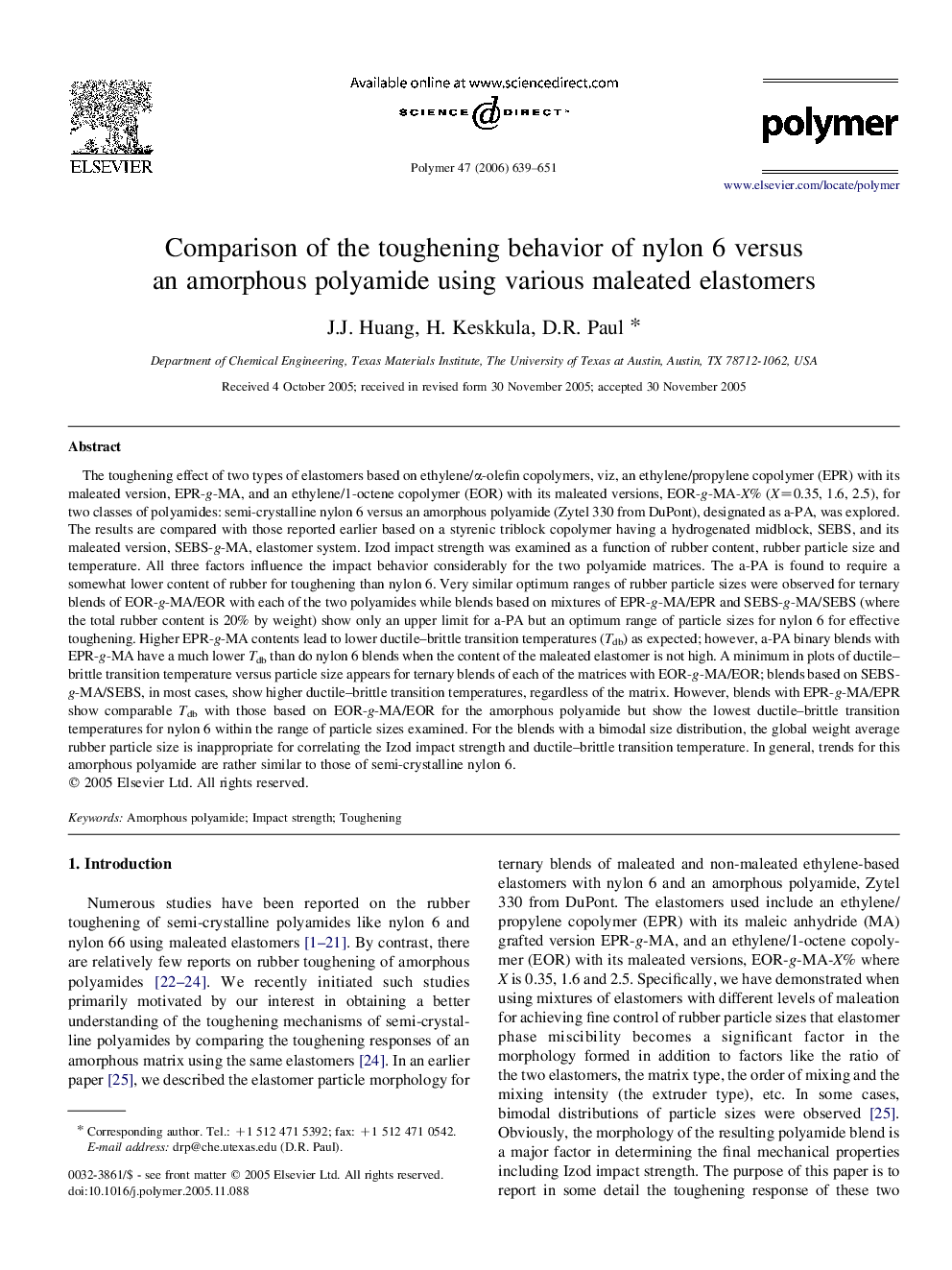| کد مقاله | کد نشریه | سال انتشار | مقاله انگلیسی | نسخه تمام متن |
|---|---|---|---|---|
| 5189415 | 1381184 | 2006 | 13 صفحه PDF | دانلود رایگان |
عنوان انگلیسی مقاله ISI
Comparison of the toughening behavior of nylon 6 versus an amorphous polyamide using various maleated elastomers
دانلود مقاله + سفارش ترجمه
دانلود مقاله ISI انگلیسی
رایگان برای ایرانیان
موضوعات مرتبط
مهندسی و علوم پایه
شیمی
شیمی آلی
پیش نمایش صفحه اول مقاله

چکیده انگلیسی
The toughening effect of two types of elastomers based on ethylene/α-olefin copolymers, viz, an ethylene/propylene copolymer (EPR) with its maleated version, EPR-g-MA, and an ethylene/1-octene copolymer (EOR) with its maleated versions, EOR-g-MA-X% (X=0.35, 1.6, 2.5), for two classes of polyamides: semi-crystalline nylon 6 versus an amorphous polyamide (Zytel 330 from DuPont), designated as a-PA, was explored. The results are compared with those reported earlier based on a styrenic triblock copolymer having a hydrogenated midblock, SEBS, and its maleated version, SEBS-g-MA, elastomer system. Izod impact strength was examined as a function of rubber content, rubber particle size and temperature. All three factors influence the impact behavior considerably for the two polyamide matrices. The a-PA is found to require a somewhat lower content of rubber for toughening than nylon 6. Very similar optimum ranges of rubber particle sizes were observed for ternary blends of EOR-g-MA/EOR with each of the two polyamides while blends based on mixtures of EPR-g-MA/EPR and SEBS-g-MA/SEBS (where the total rubber content is 20% by weight) show only an upper limit for a-PA but an optimum range of particle sizes for nylon 6 for effective toughening. Higher EPR-g-MA contents lead to lower ductile-brittle transition temperatures (Tdb) as expected; however, a-PA binary blends with EPR-g-MA have a much lower Tdb than do nylon 6 blends when the content of the maleated elastomer is not high. A minimum in plots of ductile-brittle transition temperature versus particle size appears for ternary blends of each of the matrices with EOR-g-MA/EOR; blends based on SEBS-g-MA/SEBS, in most cases, show higher ductile-brittle transition temperatures, regardless of the matrix. However, blends with EPR-g-MA/EPR show comparable Tdb with those based on EOR-g-MA/EOR for the amorphous polyamide but show the lowest ductile-brittle transition temperatures for nylon 6 within the range of particle sizes examined. For the blends with a bimodal size distribution, the global weight average rubber particle size is inappropriate for correlating the Izod impact strength and ductile-brittle transition temperature. In general, trends for this amorphous polyamide are rather similar to those of semi-crystalline nylon 6.
ناشر
Database: Elsevier - ScienceDirect (ساینس دایرکت)
Journal: Polymer - Volume 47, Issue 2, 13 January 2006, Pages 639-651
Journal: Polymer - Volume 47, Issue 2, 13 January 2006, Pages 639-651
نویسندگان
J.J. Huang, H. Keskkula, D.R. Paul,